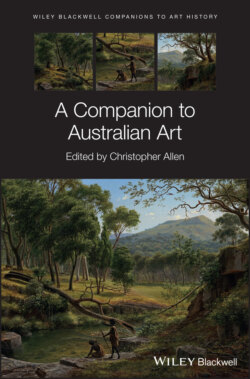Читать книгу A Companion to Australian Art - Группа авторов - Страница 25
Notes
Оглавление1 1 See, for instance, MacDonald’s notorious assertion in his 1931 article on Arthur Streeton in Art in Australia: “If we so choose we can yet be the elect of the world, the last of the pastoralists, the thoroughbred Aryans in all their nobility” (MacDonald 2006, 97).
2 2 Surrealism, in particular, according to Gleeson, provided a crucial avenue to reinvigorate the imagination in an increasingly mechanistic and socially dictated age (Gleeson 1941 in Stephen et al. 2006, 406).
3 3 See especially anthropologists Ronald and Catherine Berndt’s exhibition, Australia Aboriginal Art: Arnhem Land Paintings on Bark and Carved Human Figures (West Australian Museum, Perth, 1957).
4 4 Smith’s argument in this respect was similar to that put forth by Donald Brook in “New Art in Australia” (1972), which the development of Australian art depended upon the transformation of Australian cities into international cultural centers (Barker and Green 2011, 11).
5 5 However, as Daniel Thomas has argued, Smith was aware that Tony Tuckson’s recent touring exhibition would result in a significant publication on Aboriginal art and that Australian Painting (1962) and Australian Aboriginal Art (1964) were viewed as companion volumes by contemporary audiences (Thomas 2011, 9).
6 6 She also comments that the logical conclusion of his argument would be “that there are in each generation an extremely talented group of female artists who, if given the opportunity are likely to prove equal, if not superior to, their male counterparts…”(Burke 1980, 75).
7 7 Organized conjunctly by the South Australian Museum and the Asia Society in New York, the exhibition, Dreamings: The Art of Aboriginal Australia (1988), also timed to coincide with the bicentenary, had a profound impact on the overseas reception and understanding of Aboriginal art in its traditional and postcolonial guises.
8 8 Bonyhady reveals that “even climate change – perhaps the environmental issue most often thought of as modern – excited attention as early as 1795, when the magistrate Richard Atkins speculated that the weather was changing ‘in consequence of the country opening so fast’” (Bonyhady 2000, 4).
9 9 For more on Joan Kerr’s writing, see Candace Bruce, Dinah Dysart and Jo Holder, eds., Joan Kerr, A Singular Voice: Essays on Australian Art and Architecture. Sydney: Power Publications, 2009.
10 10 Tower Hill (1855), a distinctive landscape in the Victorian Western District, is used to demonstrate his zealous attention to plant geography through its significant role as a reference work in the environmental restoration of the district since the 1960s.
11 11 Later in a catalogue essay for the AGSA retrospective of Tom Roberts in 1996, Spate suggested that his paintings such as A Summer Morning Tiff (1886) are pervaded by a sense of uncertainty regarding the relationship between figure and bush (Butler 2005a, 10; Spate 1996). See also Humphrey McQueen’s biography of Roberts, also published in 1996, which presented a comprehensive picture of the artist’s cultural milieu and the political and social climate in which his career developed beyond the narrow parameters of a nationalist narrative.
12 12 An important precursor for this exhibition was Ladies in Landscapes, the 1974 exhibition of a more feminized Australian Impressionism curated by Ron Radford, then Director of the Ballarat Fine Art Gallery.
13 13 In addition to examining the Melbourne and Sydney landscapes of these artists, their urban views, and portraiture, the exhibition also focused on the overlapping movement of Australian symbolism, a subject later explored in its own right in the exhibition, Australian Symbolism: The Art of Dreams (AGNSW, 2012).
14 14 See also Susan Best, “Foundations of femininity: Berlei Corsets and the (Un)Masking of the Modern Body,” Continuum, 5: 1, 1991; and Holden, Robert, Cover Up: The Art of Magazine Covers in Australia, Hodder & Stoughton, Sydney, 1995.
15 15 The aforementioned edited volumes, Strange Women: Essays in Art and Gender (1994), Heritage: The National Women’s Art Book (1995) and Past Present: The National Women’s Art Anthology (1999), devote substantial sections to women and modernism. For feminist accounts of Australian art in the 1970s see Catriona Moore, ed., Dissonance: Feminism and the Arts 1970–1990. St. Leonards, NSW: Allen & Unwin, 1994.
